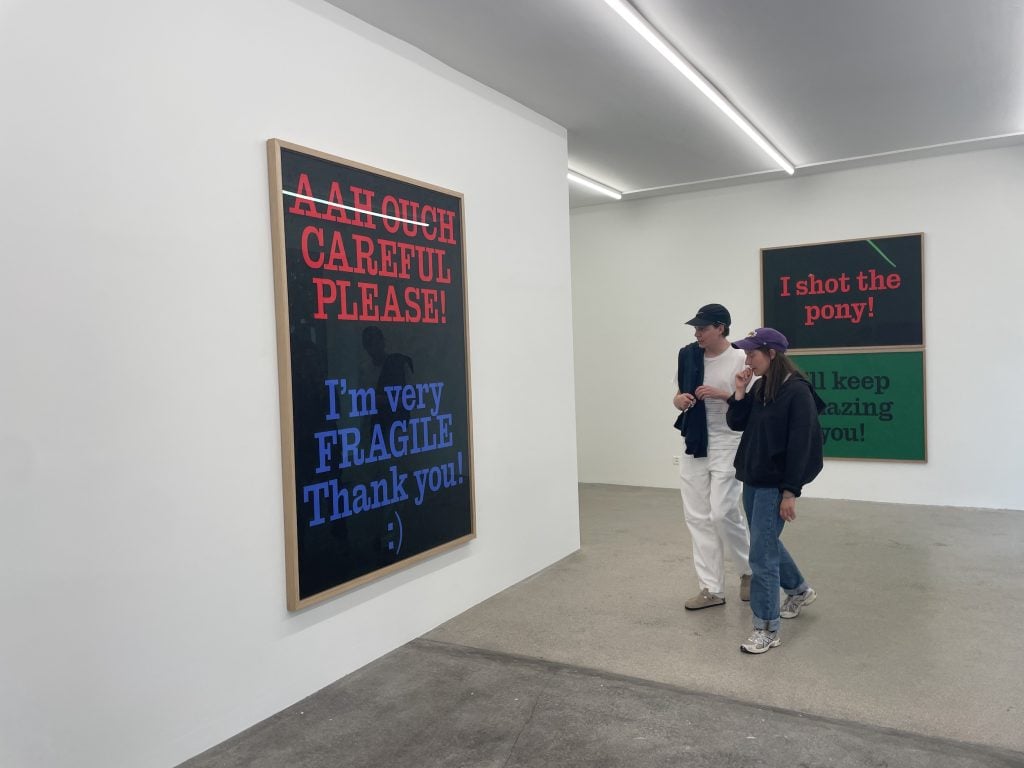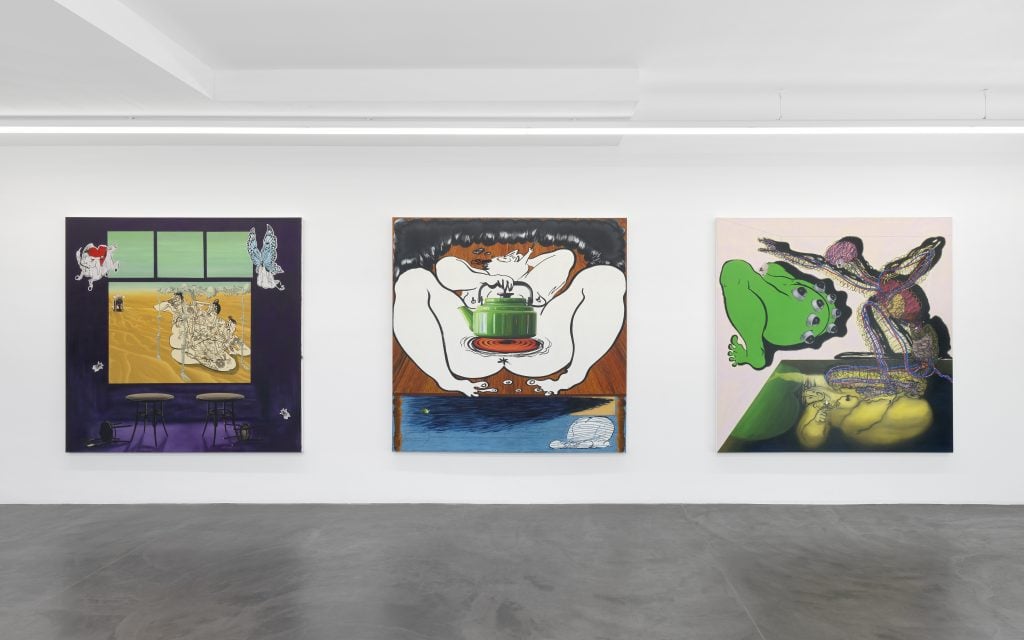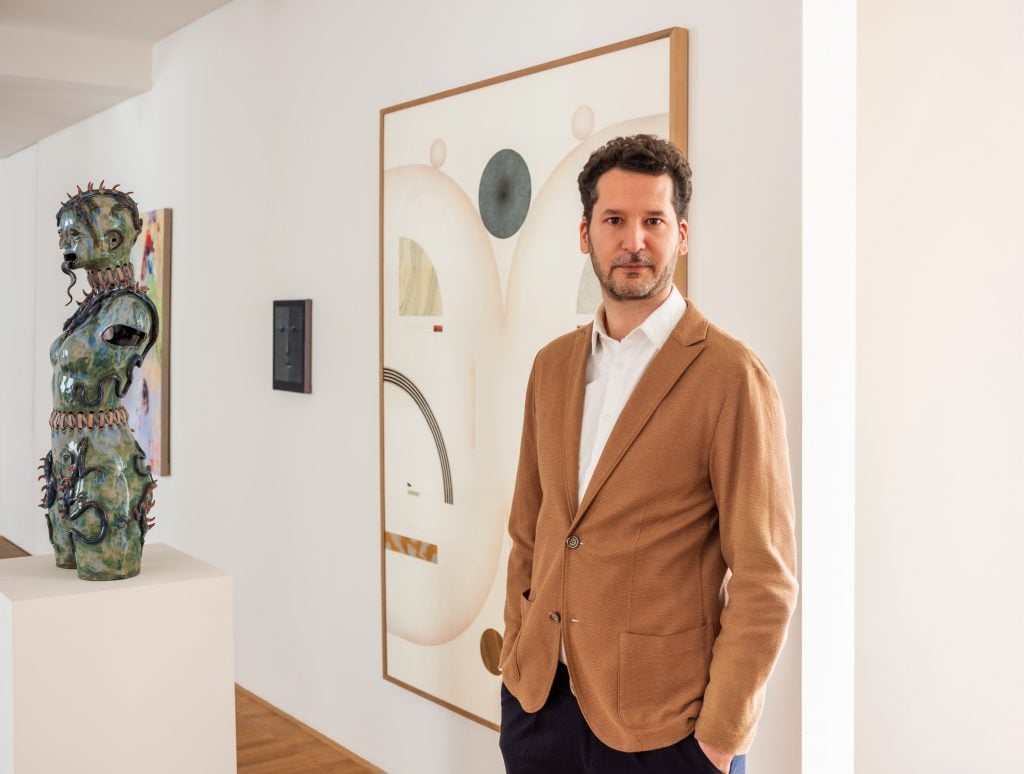Galleries
Zurich Art Weekend Is Fostering Gallery Collaborations, Drawing Crowds
Once a trade secret, the annual ritual has become an essential stop before Art Basel. This year, some 100 events were on offer.

Once a trade secret, the annual ritual has become an essential stop before Art Basel. This year, some 100 events were on offer.

Margaret Carrigan

The stereotypical view of Zurich’s art scene is that it is straitlaced and business-centric. “That’s how I felt when I left 15 years ago,” said dealer Fabian Lang, who grew up in the Swiss city before moving to London, where he worked at Victoria Miro for nearly a decade and ran a project space in the Islington neighborhood.
But Lang returned to his hometown in 2019 to start his own eponymous gallery and is part of a coterie of dealers that are energizing the city’s Old Town district. “It is so much more lively here now, and much more international,” he said.
Although the city has been wealthy for generations, thanks to its banking industry, it has also “maybe been a bit insular,” according to Lang. That has changed with the influx of multinational tech giants like Google and Apple in recent years, and the city’s population is the largest it has been since the 1960s. Its arts scene is beginning to reflect this shift.
Of course, Zurich has long boasted a roster of exceptional mid-sized regional galleries, and savvy collectors have been stopping off on their way to Basel for decades, but many others in the art world seem to have caught on to this trick. That’s due in part to Zurich Art Weekend, which hosted its seventh edition this past weekend. Founded by the art consultant and philanthropist Charlotte von Stotzingen in 2017, the event boasted around 100 exhibitions, events, and collaborations in over 65 locations across the city, and brought in roughly 35,000 visitors.
From Secret to Must-See
Lang said that the art weekend used to be small and “more of a secret for curators and collectors before Art Basel,” but now it has turned into “a must.” This year he showed new works by the Spanish artist Elena Alonso, including her signature gouache and pencil paintings, priced around CFH 17,0000 ($19,000), that abstract the human body into architectural shapes. A new series of flexible floor-based sculptures made out of leather and metal are priced between CFH 7,000 and CHF 12,000 ($7,700–$13,400).

Installation view of Nora Turato’s “the next big thing is YOU” at Galerie Gregor Staiger in Zurich. Photo: Margaret Carrigan.
“It used to be that, in a biennial year, people would go straight to Basel from Venice,” said Gregor Staiger, who co-founded his eponymous gallery with Marie Lusa in 2010. It is a founding member of Zurich Art Weekend, and Staiger said that the influx of visitors it brings is welcome.
During the weekend, Staiger showed a series of large-format text-based pastels by Nora Turato. Featuring common turns of phrase and internetisms, such as “who hurt you? :(” and “the truth is, I’m still a baby,” the works, priced in the five figures, are an extension of the Croatian artist’s performance-based and graphic design–influenced practice.
Such internationalism is a hallmark of the programming of the participating galleries. Bernheim, for instance, has mounted a two-part show of Russian artist Ebecho Muslimova’s works in tandem with Mendes Wood DM in São Paolo. Featuring a suite of new paintings that follow the shifting persona of Muslimova’s signature character, Fatebe, the first half of the exhibition, “Rumors,” opened at Mendes Wood last week before the second half, “Whispers,” opened at Bernheim.
Gallery owner Maria Bernheim said that Zurich’s art weekend has fostered a sense of collaboration among local galleries, but added that it is imperative for both artists and galleries to collaborate on a larger scale, too.

Installation view of Ebecho Muslimova’s “Whispers” at Bernheim. Photo: Annik Wetter. Courtesy of Bernheim.
“There is incredible local [collector] support in Zurich, and in Switzerland in general, which makes it very easy to sell regionally,” she said. “Ultimately, I want to be able to offer broader visibility to my artists and provide more opportunities for exchange.” Last fall, she opened a space in London to provide exactly that.
The art weekend, after all, is just a few short days of concentrated activity. “We could still do with more visitors throughout the year,” Lang said. To that end, Zurich Art Weekend has entered into a three-year collaboration with the private bank Julius Baer to help fund year-round programming. Yet, Lang said, Zurich “is not like New York or London—you still have to kind of kick people in the butt to come to things.”
The Old Made New
That’s precisely why Lang launched a community initiative in 2022 called Zurich 1 that helps organize regular events and exhibition openings throughout the year with the growing cluster of galleries in Old Town, near the Kunsthaus Zurich, whose 2021 David Chipperfield-designed expansion helped redefine the area as a cultural destination.
“You know, we are a very Protestant city in that there is nothing too flashy or big, so the opening of this monumental space was a big deal,” Lang said. Established local galleries like Urs Meile and Mai 36 had been stalwarts of Old Town prior to the museum’s expansion, but much of the historic district had taken over by high-street chains and tourist traps.

Fabian Lang. Photo: Mark O’Flaherty. Courtesy Galerie Fabian Lang.
In the last couple of years, galleries have been reclaiming the area’s retail spaces, among them Bernheim as well as Steiger, who relocated earlier this year from the Löwenbraü complex, a 19th-century brewery facility that has been a hub for commercial and nonprofit enterprises since the late 1990s.
“When we launched Zurich 1, there were maybe five or six galleries; now we are 16,” Lang said, noting that its members range from younger outfits like his to more established dealers like Eva Presenheuber.
Galleries coalescing in an area is, of course, nothing new, but as mid-tier dealers battle rising overheads and predatory high-end dealers on the hunt for new talent, sticking together may be a key means of survival, as further evidenced by the recent uptick in joint representation of artists by mid-sized galleries.
Working with other dealers is “the only way I want to do business,” Bernheim said. “Artists need mid-sized galleries to help nurture their careers, and I think [collaboration] is the only way for galleries like mine to continue to exist in the face of the big ones that keep gobbling up all the artists.”